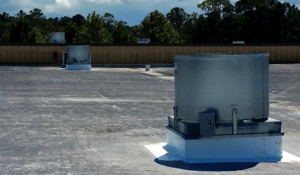Powered Ventilation: 3 Times When it Works Best
Powered ventilation is sometimes the solution. At Moffitt natural ventilation is always our first choice. However we’ve worked on enough buildings to know it’s not always the best solution. There are plenty of reasons why natural ventilation might not be a good fit on a given building; from climate region to EPA regulations. That’s why Moffitt also provides a complete line of fans powered by Moffitt. Listed below are 3 times when Powered Ventilation Works Best.
1) Low to Medium Process Heat
 Natural ventilation works best in facilities with high internal temperatures. Essentially, any time the production equipment gives off a lot of heat, natural ventilation can help. The high temperatures mean the hot air will quickly rise up and out through a natural ventilator, making it the best solution. On the other hand, buildings without high process heat work differently. An assembly plant may be hot and stuffy but not so hot that the heat will naturally exhaust with a ventilator. Instead this heat will linger around the workers.
Natural ventilation works best in facilities with high internal temperatures. Essentially, any time the production equipment gives off a lot of heat, natural ventilation can help. The high temperatures mean the hot air will quickly rise up and out through a natural ventilator, making it the best solution. On the other hand, buildings without high process heat work differently. An assembly plant may be hot and stuffy but not so hot that the heat will naturally exhaust with a ventilator. Instead this heat will linger around the workers.
Facilities with low to medium process heat can get more use out of power ventilators like fans. Fans will pull this warm air out of the facility instead of letting it stagnate. This will result in a more comfortable work space.
2) Moderate Ceiling Height
Natural ventilation is very effective in buildings with a high ceiling height. This is because the hot air rises to the ceiling, far away from the people below. A hot building with a low ceiling will result in hot air lingering around the workers.
In situations such as these exhaust fans are the key. When installed on low ceilings they draw in the warm air and expel it out through the roof. While fans on a tall ceiling are often too far away for the workers to feel anything, fans on a low ceiling can make a big difference.
3) Budget and Affordability
One of the biggest benefits of a natural ventilator is that it pays for itself in just a few years. As it requires no electricity to run and requires no maintenance it can save a plant lots of money. There are instances where a natural ventilator has a higher first cost though. A complicated installation or complex options can increase the price.
Some facilities really only require a few fans. Whether it’s the moderate temperatures or forgiving climate, they may just need a few units around the facility. In these situations, installing a new exhaust fan every couple of years is actually more affordable. Furthermore, on a facility that already needs regular roof maintenance for other equipment, repairing fans may not be an issue. For these plants, powered ventilation is the right solution.
Powered By Moffitt
These are just three examples of when powered ventilation is the right solution. As mentioned above there are a number of other factors that can influence the choice between a natural system and a powered one. That’s where we come in. The team at Moffitt has been designing, manufacturing, and installing ventilation systems for almost 60 years. We can tell you which solution is right for your facility. We’re not going to sell you a massive ventilator when a few fans will do the trick, but we’re also going to encourage you to go with a ventilator if it is more efficient and more economical. This complete system approach is the Moffitt Difference. Contact Moffitt today to learn more.
